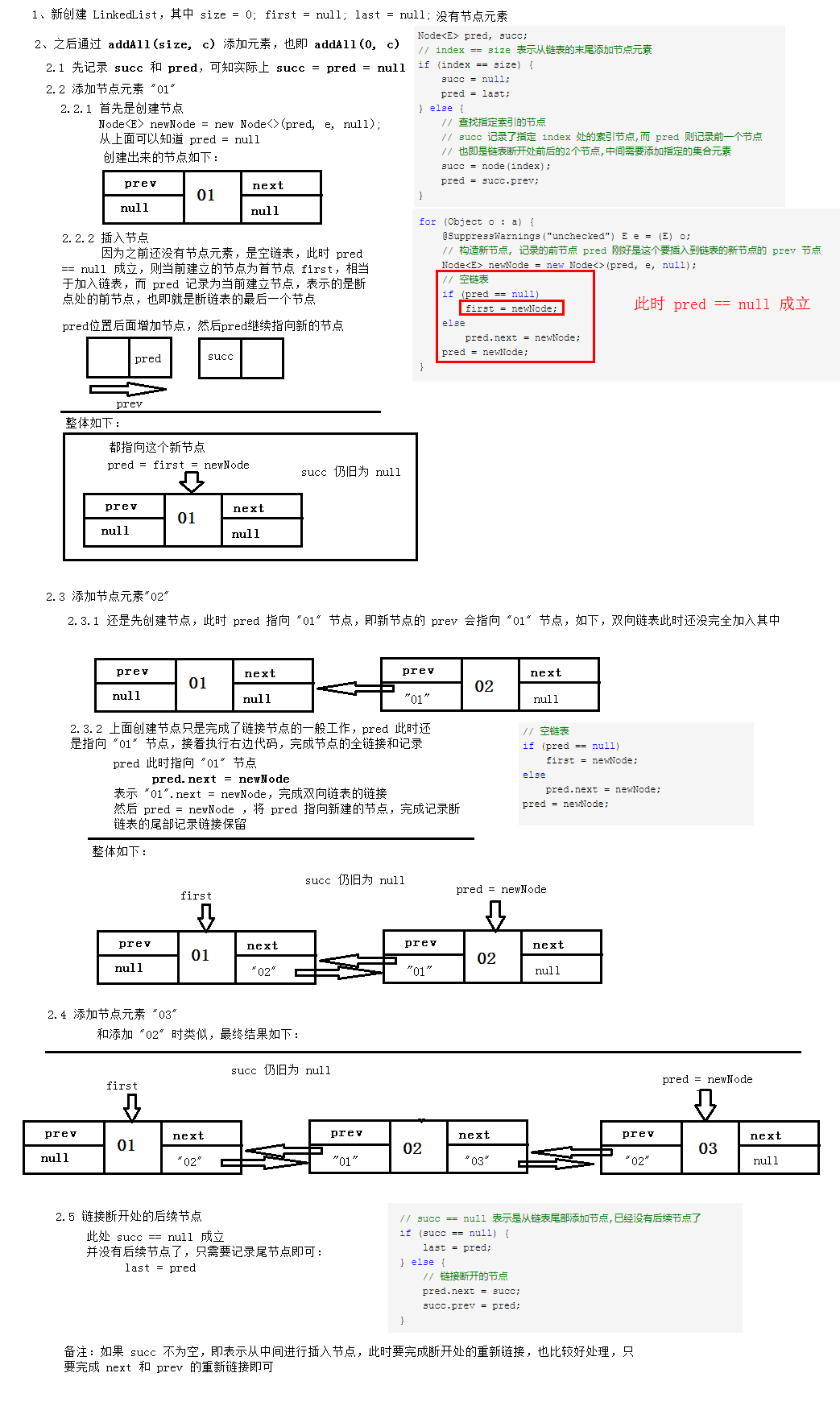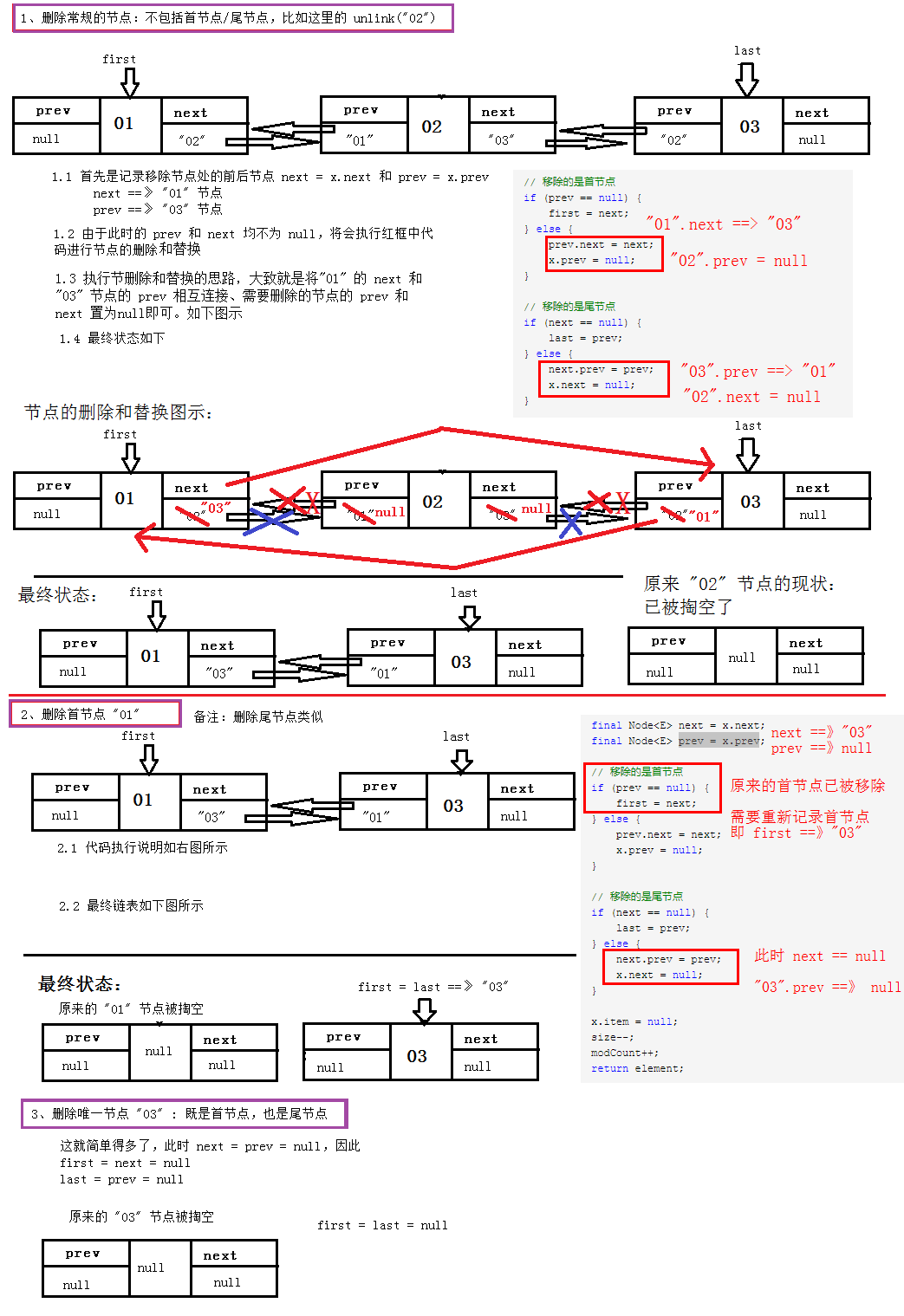Java8集合框架——LinkedList源码分析
java.util.LinkedList
本文的主要目录结构:
- 一、LinkedList的特点及与ArrayList的比较
- 二、LinkedList的内部实现
- 三、LinkedList添加元素
- 四、LinkedList查找元素
- 五、LinkedList删除元素
- 六、LinkedList修改元素
一、LinkedList的特点及与ArrayList的比较
对比上一篇的ArrayList介绍【传送门:Java8集合框架——ArrayList源码分析】,LinkedList因内部实现不同,其元素的内部访问方式也不一样。LinkedList的特点大致和ArrayList的比较如下:
| 关注的问题点 | ArrayList相关结论 | LinkedList相关结论 |
|
是否允许空的元素 |
是 | 是 |
| 是否允许重复的元素 | 是 | 是 |
|
元素有序:读取数据和存放数据的顺序一致 |
是 | 是 |
| 是否线程安全 | 否 | 否 |
| 随机访问的效率 | 随机访问指定索引(数组的索引)的元素快 | 因需要进行遍历,随机访问指定索引的元素较慢,而利用双向链表的特性,可以从两端进行访问,会使得平均访问的元素减少一半 |
| 顺序添加元素的效率 |
在不涉及扩容时,顺序添加元素速度快; 当需要扩容时,涉及到元素的复制,相对较慢 |
顺序添加元素速度快,只是新建一个结点,然后添加结点链接; |
| 删除和插入元素的效率 |
因涉及到复制和移动后续的元素,相对较慢 |
删除和插入涉及到遍历找到相关结点,因此会慢点,但是找到结点后的相关操作会比较快,因不涉及到元素的移动 |
二、LinkedList的内部实现
1、内部重要属性说明
LinkedList是以双向链表为基础实现列表的集合,内部实现结点中,有指向上一个结点 prev 和下一个结点next 的引用,即双向链表,而 E item 即为实际的存储元素,实现源码如下:
private static class Node<E> {
E item; // 实际存储的元素
Node<E> next; // 下一个元素的引用
Node<E> prev; // 上一个元素的引用
Node(Node<E> prev, E element, Node<E> next) {
this.item = element;
this.next = next;
this.prev = prev;
}
}
LinkedList内部有几个重要属性,比如说保存了元素个数、首结点引用和尾结点引用等,因此要获得LinkedList的首元素和尾元素元素也比较直接。
// 实际存储的元素个数
transient int size = 0; /**
* Pointer to first node.
* 第一个节点元素的引用
* Invariant: (first == null && last == null) ||
* (first.prev == null && first.item != null)
*/
transient Node<E> first; /**
* Pointer to last node.
* 最后一个节点元素的引用
* Invariant: (first == null && last == null) ||
* (last.next == null && last.item != null)
*/
transient Node<E> last;
2、构造函数说明
1、空构造函数
/**
* Constructs an empty list.
*/
public LinkedList() {
}
2、带参构造函数:通过指定集合构建
/**
* Constructs a list containing the elements of the specified
* collection, in the order they are returned by the collection's
* iterator.
*
* @param c the collection whose elements are to be placed into this list
* @throws NullPointerException if the specified collection is null
* 如果指定集合为空,会抛出NPE
*/
public LinkedList(Collection<? extends E> c) {
this();
addAll(c);
}
这个带参的构造函数其实比较好理解,通过指定集合构建的LinkedList,其实就是创建一个空的 LinkedList,然后把集合里面的所有元素添加进去。而添加集合元素调用的 addAll(c) ,实际上只是从指定索引处(这里是从末尾,即 size 处)添加所有的集合元素:addAll(size, c) 。
/**
* Appends all of the elements in the specified collection to the end of
* this list, in the order that they are returned by the specified
* collection's iterator. The behavior of this operation is undefined if
* the specified collection is modified while the operation is in
* progress. (Note that this will occur if the specified collection is
* this list, and it's nonempty.)
*
* 往LinkedList中添加指定集合的所有元素
*
* @param c collection containing elements to be added to this list
* @return {@code true} if this list changed as a result of the call
* @throws NullPointerException if the specified collection is null
*/
public boolean addAll(Collection<? extends E> c) {
// 从索引 size 处添加索引,即从末尾添加节点
return addAll(size, c);
}
再来看看 addAll(size, c) 的具体实现:
/**
* Inserts all of the elements in the specified collection into this
* list, starting at the specified position. Shifts the element
* currently at that position (if any) and any subsequent elements to
* the right (increases their indices). The new elements will appear
* in the list in the order that they are returned by the
* specified collection's iterator.
*
* 往LinkedList的指定索引处添加指定集合的所有元素
*
* @param index index at which to insert the first element
* from the specified collection
* @param c collection containing elements to be added to this list
* @return {@code true} if this list changed as a result of the call
* @throws IndexOutOfBoundsException {@inheritDoc}
* @throws NullPointerException if the specified collection is null
*/
public boolean addAll(int index, Collection<? extends E> c) {
// index 的边界检查
checkPositionIndex(index); Object[] a = c.toArray();
int numNew = a.length;
if (numNew == 0)
return false; Node<E> pred, succ;
// index == size 表示从链表的末尾添加节点元素
if (index == size) {
succ = null;
pred = last;
} else {
// 查找指定索引的节点
// succ 记录了指定 index 处的索引节点,而 pred 则记录前一个节点
// 也即是链表断开处前后的2个节点,中间需要添加指定的集合元素
succ = node(index);
pred = succ.prev;
} for (Object o : a) {
@SuppressWarnings("unchecked") E e = (E) o;
// 构造新节点, 记录的前节点 pred 刚好是这个要插入到链表的新节点的 prev 节点
Node<E> newNode = new Node<>(pred, e, null);
// 空链表
if (pred == null)
first = newNode;
else
pred.next = newNode;
pred = newNode;
} // succ == null 表示是从链表尾部添加节点,已经没有后续节点了
if (succ == null) {
last = pred;
} else {
// 链接断开的节点
pred.next = succ;
succ.prev = pred;
} // 记录实际元素个数 size 和已修改次数 modCount
size += numNew;
modCount++;
return true;
} // 对下表索引进行边界检查
private void checkPositionIndex(int index) {
if (!isPositionIndex(index))
throw new IndexOutOfBoundsException(outOfBoundsMsg(index));
}
/**
* Tells if the argument is the index of a valid position for an
* iterator or an add operation.
* 实际上就是直接与内部属性 size 的比较, 即必须落在 0 ~ size 之间,因为这是链表的实际位置
*/
private boolean isPositionIndex(int index) {
return index >= 0 && index <= size;
}
/**
* Returns the (non-null) Node at the specified element index.
* 查找指定索引的节点
*/
Node<E> node(int index) {
// assert isElementIndex(index); // 利用双向链表的特性,看要查找的索引是落在前半部分还是后半部分,然后顺着查或者逆着查,可节省遍历的时间
if (index < (size >> 1)) {
Node<E> x = first;
for (int i = 0; i < index; i++)
x = x.next;
return x;
} else {
Node<E> x = last;
for (int i = size - 1; i > index; i--)
x = x.prev;
return x;
}
}
下面通过图示和文字进行具体的说明:
List<String> arrayList = new ArrayList<>();
arrayList.add("01");
arrayList.add("02");
arrayList.add("03");
List<String> linkedList = new LinkedList<>(arrayList);

大致图示如上。
三、 LinkedList添加元素
1、顺序添加元素
直接上源码:
/**
* Appends the specified element to the end of this list.
*
* <p>This method is equivalent to {@link #addLast}.
*
* @param e element to be appended to this list
* @return {@code true} (as specified by {@link Collection#add})
*/
public boolean add(E e) {
linkLast(e); // 顺序添加新元素,其实是从链表最后添加1个节点
return true;
} /**
* Links e as last element.
*/
void linkLast(E e) {
final Node<E> l = last;
final Node<E> newNode = new Node<>(l, e, null); // 新建节点: prev 为之前的尾节点 last,单链接完成
last = newNode; // 新节点即为尾节点
if (l == null)
first = newNode; // 原来的尾节点为 null,说明是空链表,需要记录首节点
else
l.next = newNode; // 记录原尾节点的 next指向,完成双向链接
size++; // 记录实际元素个数 size 和已修改次数 modCount
modCount++;
}
这段源码其实挺好理解的,大意就是
- 创建引用 l,指向原尾元素 last
- 创建新结点 newNode,该节点的 prev 指向保存的原尾节点引用 l,完成链表的单向链接
- 尾节点引用 last 指向新结点 newNode,作为新的尾节点
- 若原尾节点引用 l 为空,说明此时刚刚添加第一个元素,之前都没有元素,是个空链表,first 和 last 都为空,则首节点引用 first 指向新建节点 newNode,此时,first、last都指向同一个节点 newNode;否则,原尾节点的 next 指向 newNode,完成链表的双向链接
- 记录实际元素个数 size 和已修改次数 modCount
2、指定索引插入元素
- 判断是否越界
- 若没有越界,则再判断是否是尾节点添加,若是,直接顺序添加
- 若不是,则先找到指定索引的元素结点(参考下一小节),然后执行结点变更操作,和前面的 addAll 中的做法类似,这里就不细讲。
/**
* Inserts the specified element at the specified position in this list.
* Shifts the element currently at that position (if any) and any
* subsequent elements to the right (adds one to their indices).
*
* @param index index at which the specified element is to be inserted
* @param element element to be inserted
* @throws IndexOutOfBoundsException {@inheritDoc}
*/
public void add(int index, E element) {
// index 的边界检查
checkPositionIndex(index); // index == size ,则相当于从最后添加元素
if (index == size)
linkLast(element);
else
linkBefore(element, node(index));
}
/**
* Inserts element e before non-null Node succ.
* 在指定节点前添加元素
*/
void linkBefore(E e, Node<E> succ) {
// assert succ != null;
final Node<E> pred = succ.prev;
final Node<E> newNode = new Node<>(pred, e, succ);
succ.prev = newNode;
if (pred == null)
first = newNode; // 说明从首节点处插入节点, index = 0
else
pred.next = newNode;
size++;
modCount++;
}
四、LinkedList查找元素
根据指定索引查找元素。这里使用了双向链表的特性,可以向前或者向后顺序查找,即判断索引落在前半部分(index < (size >> 1)),向后索引,落在后半部分,向前索引,这就能保证最多只要遍历一半,提高效率。
/**
* Returns the element at the specified position in this list.
*
* @param index index of the element to return
* @return the element at the specified position in this list
* @throws IndexOutOfBoundsException {@inheritDoc}
*/
public E get(int index) {
checkElementIndex(index); // index 的边界检查
return node(index).item;
}
/**
* Returns the (non-null) Node at the specified element index.
*/
Node<E> node(int index) {
// assert isElementIndex(index); // 利用双向链表的特性,看要查找的索引是落在前半部分还是后半部分,然后顺着查或者逆着查,可节省遍历的时间
if (index < (size >> 1)) {
Node<E> x = first;
for (int i = 0; i < index; i++)
x = x.next;
return x;
} else {
Node<E> x = last;
for (int i = size - 1; i > index; i--)
x = x.prev;
return x;
}
}
五、LinkedList删除元素
和ArrayList类似,删除元素也有2种
- 指定索引删除
- 指定元素删除
指定元素删除,是根据元素顺序进行判断直到找到相应的元素的,因此效率不高,从这里也可以看到,元素可以为null,因为null(使用==)和实际元素(使用equals)的对等判断是不一样的方法;指定索引也是需要先找到索引所对应的元素,然后再删除元素。
/**
* Removes the first occurrence of the specified element from this list,
* if it is present. If this list does not contain the element, it is
* unchanged. More formally, removes the element with the lowest index
* {@code i} such that
* <tt>(o==null ? get(i)==null : o.equals(get(i)))</tt>
* (if such an element exists). Returns {@code true} if this list
* contained the specified element (or equivalently, if this list
* changed as a result of the call).
* 移除指定元素
*
* @param o element to be removed from this list, if present
* @return {@code true} if this list contained the specified element
*/
public boolean remove(Object o) {
if (o == null) {
for (Node<E> x = first; x != null; x = x.next) {
if (x.item == null) {
unlink(x);
return true;
}
}
} else {
for (Node<E> x = first; x != null; x = x.next) {
if (o.equals(x.item)) {
unlink(x);
return true;
}
}
}
return false;
}
/**
* Removes the element at the specified position in this list. Shifts any
* subsequent elements to the left (subtracts one from their indices).
* Returns the element that was removed from the list.
* 移除指定索引的元素
*
* @param index the index of the element to be removed
* @return the element previously at the specified position
* @throws IndexOutOfBoundsException {@inheritDoc}
*/
public E remove(int index) {
checkElementIndex(index);
return unlink(node(index));
}
从实现来看,最后删除元素都是直接调用了unlink(Node n)。
/**
* Unlinks non-null node x.
* 移除一个非空节点
*/
E unlink(Node<E> x) {
// assert x != null;
final E element = x.item;
final Node<E> next = x.next;
final Node<E> prev = x.prev; // 移除的是首节点
if (prev == null) {
first = next;
} else {
prev.next = next;
x.prev = null;
} // 移除的是尾节点
if (next == null) {
last = prev;
} else {
next.prev = prev;
x.next = null;
} x.item = null;
size--;
modCount++;
return element;
}
这里大致讲一下。说白了,就是结点引用的变更,一个图就可以说明,如下。
- prev.next = next; 表示上一个元素的 next 指向本结点的 next 实际元素,即跳过本结点链接到下一个结点,如左边的红箭头
- next.prev = prev; 表示下一个元素的 prev 指向本结点的 prev 实际元素,即跳过本结点链接到上一个结点,如右边的红箭头。
这样便完成了链接的变更。当然这里还考虑了该元素是否是首元素(首元素 first 下移一格为 next)、是否是尾元素(尾元素 last 上移一格为 prev)。如下3种场景(删除普通节点、删除首节点或者尾节点、删除唯一节点)图示:

六、LinkedList修改元素
可以到,这里也是引用了 node(index),要顺序找到相应的元素,所以比较慢,但是一旦找到元素,就只会变更相关结点信息,这部分操作还是比较快的。
/**
* Replaces the element at the specified position in this list with the
* specified element.
*
* @param index index of the element to replace
* @param element element to be stored at the specified position
* @return the element previously at the specified position
* @throws IndexOutOfBoundsException {@inheritDoc}
*/
public E set(int index, E element) {
checkElementIndex(index);
Node<E> x = node(index);
E oldVal = x.item;
x.item = element;
return oldVal;
}
作为 List 的基本功能大致说明如上 。
Java8集合框架——LinkedList源码分析的更多相关文章
- Java8集合框架——ArrayList源码分析
java.util.ArrayList 以下为主要介绍要点,从 Java 8 出发: 一.ArrayList的特点概述 二.ArrayList的内部实现:从内部属性和构造函数说起 三.ArrayLis ...
- Java8集合框架——LinkedHashMap源码分析
本文的结构如下: 一.LinkedHashMap 的 Javadoc 文档注释和简要说明 二.LinkedHashMap 的内部实现:一些扩展属性和构造函数 三.LinkedHashMap 的 put ...
- Java8集合框架——HashMap源码分析
java.util.HashMap 本文目录: 一.HashMap 的特点概述和说明 二.HashMap 的内部实现:从内部属性和构造函数说起 三.HashMap 的 put 操作 四.HashMap ...
- Java8集合框架——LinkedHashSet源码分析
本文的目录结构如下: 一.LinkedHashSet 的 Javadoc 文档注释和简要说明 二.LinkedHashSet 的内部实现:构造函数 三.LinkedHashSet 的 add 操作和 ...
- Java8集合框架——HashSet源码分析
本文的目录结构: 一.HashSet 的 Javadoc 文档注释和简要说明 二.HashSet 的内部实现:内部属性和构造函数 三.HashSet 的 add 操作和扩容 四.HashSet 的 r ...
- Java集合之LinkedList源码分析
概述 LinkedLIst和ArrayLIst一样, 都实现了List接口, 但其内部的数据结构不同, LinkedList是基于链表实现的(从名字也能看出来), 随机访问效率要比ArrayList差 ...
- 死磕 java集合之LinkedList源码分析
问题 (1)LinkedList只是一个List吗? (2)LinkedList还有其它什么特性吗? (3)LinkedList为啥经常拿出来跟ArrayList比较? (4)我为什么把LinkedL ...
- 集合之LinkedList源码分析
转载请注明出处:http://www.cnblogs.com/qm-article/p/8903893.html 一.介绍 在介绍该源码之前,先来了解一下链表,接触过数据结构的都知道,有种结构叫链表, ...
- Java基础-集合框架-ArrayList源码分析
一.JDK中ArrayList是如何实现的 1.先看下ArrayList从上而下的层次图: 说明: 从图中可以看出,ArrayList只是最下层的实现类,集合的规则和扩展都是AbstractList. ...
随机推荐
- window 命令行telnet 不能用问题
如图 解决办法 打开window控制面板,启用或关闭window功能,勾选telnet选项.
- 学生选课数据库MySQL语句练习题45道
1. 查询Student表中的所有记录的Sname.Ssex和Class列. select Sname,Ssex,Class from Student;2. 查询教师所有的单位即不重复的Depart列 ...
- ZOJ 3802 Easy 2048 Again 状态DP
zoj 上次的月赛题,相当牛的题目啊,根本想不到是状态压缩好吧 有个预先要知道的,即500个16相加那也是不会超过8192,即,合并最多合并到4096,只有2的12次方 所以用状态压缩表示前面有的序列 ...
- writeObiect与序列化反序列化
在写仿QQ聊天工具中,客户端与服务端之间的通信一开始是采用的是InputStream和OutputStream,这导致在数据传输过程中,登录信息,注册信息等难以区分,这时我给传输的数据加了标识来分辨信 ...
- c/c++ 计算屏幕的PPI
PPI(pixels per inch)是图像分辨率的单位,表示的是每英寸所拥有的像素(pixel)数目.那如何计算勒?其实PPI计算有这相应的公式,公式为:sqrt(横向的平方+纵向的平方)/屏幕尺 ...
- 基于高德开放平台Map Lab的数据可视化
在Map Lab上创建可视化项目,首先需要添加数据.添加数据有4种方式,分别是: 上传CSV文件添加数据 上传Excel文件添加数据 连接在线数据库添加数据 提供在线数据API添加数据 一.数据上传说 ...
- idea创建同名的maven工程时报错:Failed to create a Maven project 'xxx/pom.xml' already exists in VFS
1.说明 原先有个 xxx 的 maven 工程,然后删掉了,又重新建了个同名的工程,而且目录也一样,结果报错: 可以在 Help ==> Show Log in Explorer 查看到以下具 ...
- [JZOJ]1293.气象牛[区间DP]
Description 为了研究农场的气候,Betsy帮助农夫John做了N(1 <= N <= 100)次气压测量并按顺序记录了结果M_1-M_N(1 <= M_i <= 1 ...
- SPOJ DQUERY D-query 离线+树状数组
本来是想找个主席树的题目来练一下的,这个题目虽说可以用主席树做,但是用这个方法感觉更加叼炸天 第一次做这种离线方法,所谓离线,就在把所有询问先存贮起来,预处理之后再一个一个操作 像这个题目,每个操作要 ...
- Python 内置类型 dict, list,线程安全吗
近段时间发现一个 Python 连接数据库的连接是线程不安全的,结果惹得我哪哪儿都怀疑变量的多线程是否安全的问题,今天终于找到了正确答案,那就是 Python 内置类型 dict,list ,tupl ...
